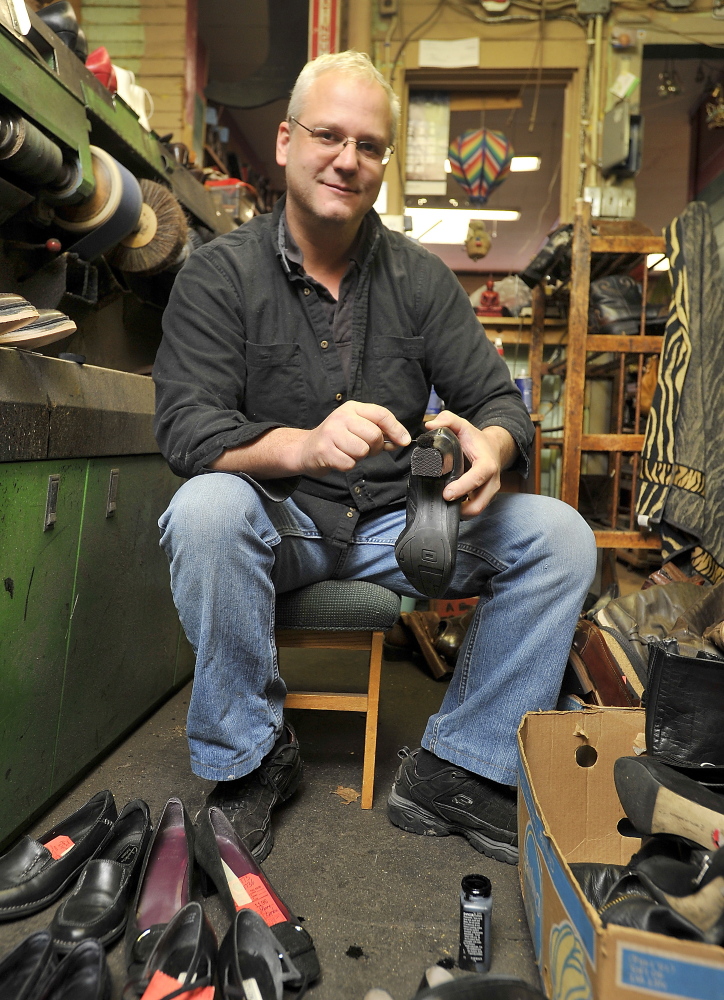Dan Lentz, owner of Roy’s Shoe Repair on Stevens Avenue in Portland, is the man you go to if you’d rather make that tired old pair of boots last a few more years than toss them in the landfill. Textiles, including footwear, made up 5.7 percent of municipal solid waste in 2012, according to the Environmental Protection Agency. We called Lentz to talk environmentally friendly shoe repair, why his business is thriving and when it’s time to let those old loafers go.
WHO’S ROY? Roy’s Shoe Repair was founded in 1923 by George Roy Sr. George Roy Jr. sold the business in 1981 to Dan Lentz’s father, Steve, who had worked for the Roys since 1956. The Lentz family never changed the name because “George Roy (Jr.) was like a father to my dad,” Lentz said. “They could read each other’s minds.” These days, Dan runs it with help from his daughter Marisa, who is 21 and started about a year ago. Meanwhile, Steve Lentz, 76, lives upstairs from the shop and comes down when he’s in the mood.
RECESSION TIMES: From an outsider’s perspective, it seems like a recession might be good for a shoe-repair business. Has that been the case for Roy’s? Lentz said it’s been nicely busy for the past 12 or 15 years, especially at this time of the year. But it’s not so much about the recession as it is a drop in quality of manufacturing; more shoes need fixing. “They keep cutting the quality down,” Lentz said. “Take a name like Dexter Shoe. Those were good shoes mostly through the ’80s. Then it just tanked, and now I just don’t recommend the brand. Same with Bass.” But he’s taken with the Maine-made shoes put out by third-generation shoemakers at Rancourt & Co. in Lewiston.
LOUSY LEATHER? Often the same things that make a shoe cheap, like vinyl and plastic materials, are the things that make Lentz’s job harder. “It’s a fight for me to use my adhesives on plastic,” he said.
NOT WORTH IT: Sometimes, he gently suggests, it’s not worth it. “I have told people that,” he said. “Because it is my reputation on the line.” In some cases, he can repair shoes with materials that will wear better than the originals. Not always, though. “What I tell people is, if the repair is going to cost $40 or $60 and they only paid $80 for the shoes, then a $60 repair doesn’t fly.”
THESE BOOTS WERE MADE FOR: He advocates for some shoes. “If I see an older, quality pair of shoes that reflects good workmanship, I will tell them that these are made right, these were made to be repaired,” Lentz said. “In those cases, it is easily worth it.”
FEW AND FAR BETWEEN: Roy’s is the only cobbler left in Portland. There’s one in South Portland, another in Westbrook, and in Scarborough, Lentz’s brother Mike runs another Roy’s. Why so few in an age when we all have to watch our pennies? Lenz’s theory: “It’s not a computerized industry,” he said. “It’s old-fashioned work with your hands.” There are shoe repairmen, he said, and then there are artists. “Not to toot my own horn, but I’m one of them.”
OLD SHOES: His own oldest pair of shoes is a pair of welding boots that he got when he was 15. And the penny loafers that he wore at Deering High School (he graduated in 1985). He used his trade to keep those well-loved loafers going through five years of near constant wear. “I did a lot of work on those,” he said. Even after they were out of fashion and too tight, he didn’t let go; they’re in a box in the attic.
GREEN BUSINESS: If you want a “green” sole, Lentz can put one on for you that’s made out of recycled rubber. He prefers the classic Vibram sole, but he believes in going green, and he’s a major recycler of shoe and purse parts himself. Abandoned shoes and bags get picked clean. “I take all the salvage parts off of it I can use,” he said, including buckles, zippers and metal loops.
NEW TRADE: And he’s learning to make shoes himself. “I have been studying it on YouTube,” he said. His first shoe is likely to be something where “the looks wouldn’t be important, because I think my shoe-making skills would be rough at first,” he said. “I want to work on getting the quality right.”
OTHER LIVES: Did Lentz ever want to do something outside the family business? He said he didn’t take anything seriously until he was married at 24 and had a mortgage payment. “That’s when I really got to working,” he said. “I did get disenchanted with the business – I guess it was 1998 or so.” He took some courses and thought about becoming an electrician. Instead he got deeper into the cobbler business. “I aced all my courses and that just boosted my self esteem,” Lentz said. And it made him happier. “That’s what saved my business: just a total change in attitude.”
Correction: This story was updated at 1:25 p.m. on January 4, 2015 to correct the spelling of the cobbler’s last name.
Copy the Story LinkSend questions/comments to the editors.




Success. Please wait for the page to reload. If the page does not reload within 5 seconds, please refresh the page.
Enter your email and password to access comments.
Hi, to comment on stories you must . This profile is in addition to your subscription and website login.
Already have a commenting profile? .
Invalid username/password.
Please check your email to confirm and complete your registration.
Only subscribers are eligible to post comments. Please subscribe or login first for digital access. Here’s why.
Use the form below to reset your password. When you've submitted your account email, we will send an email with a reset code.